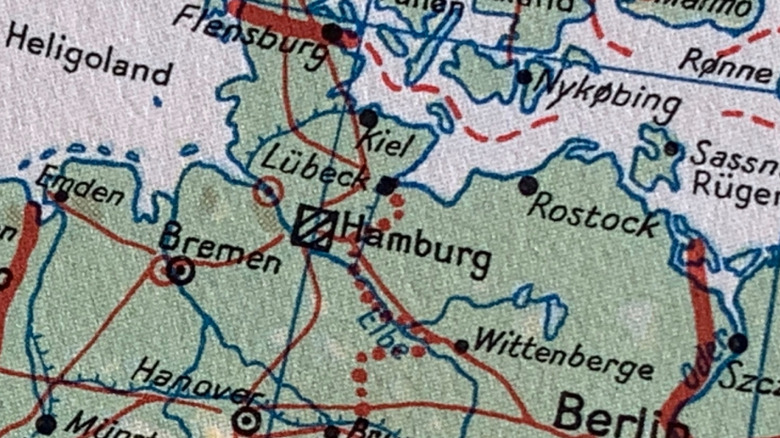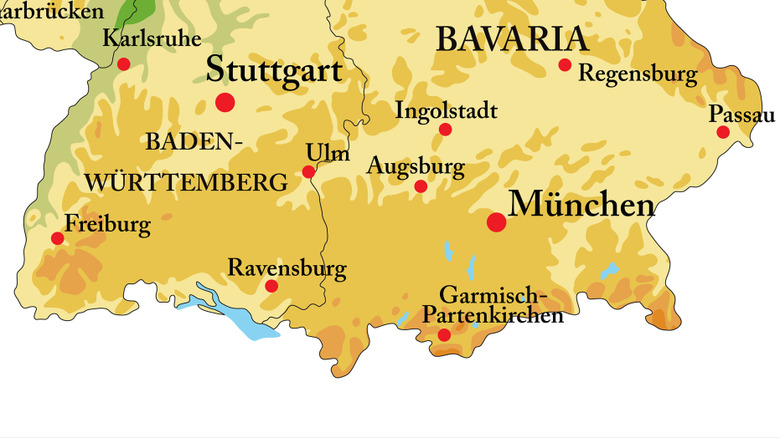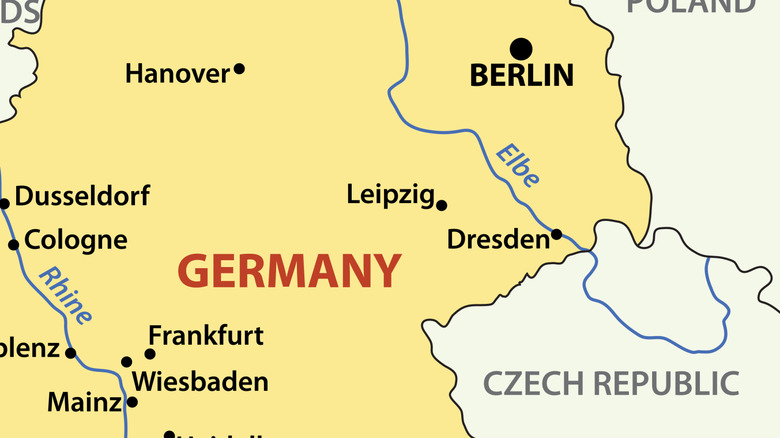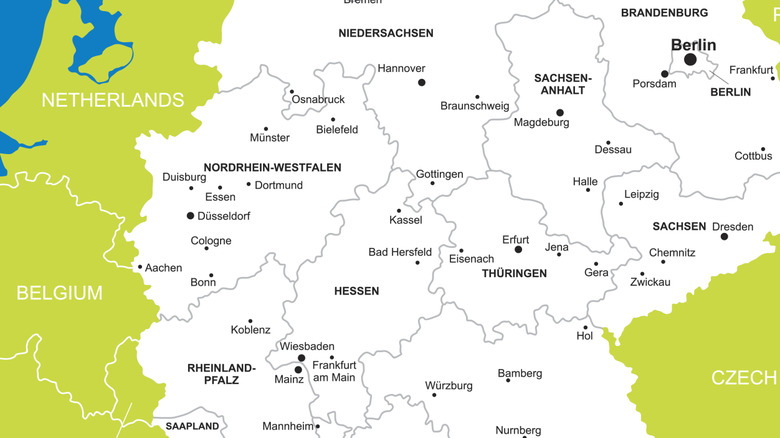The Only Map Of Germany You Need For Your Upcoming Trip
Germany as we know it today has only existed since its reunification following the fall of the Soviet-imposed Berlin Wall in 1989 (it became officially reunified after a vote in 1990). However, it is a country with a long, rich, and checkered history and a land characterized in turns by both strongly held traditions and forward-thinking innovation.
Covering some 138,000 square miles, Germany is a land well worth exploring on any trip to Europe. But where to go? While Berlin might be an obvious choice, the truth is that each of Germany's 16 states has plenty to offer, and with a country-wide (and generally reliable) rail system, the famous autobahn that makes the country a dream for drivers, and huge networks of both biking and hiking routes, there is no reason to stay in just one place. If you have the time, touring around Germany can lead to some incredible discoveries.
Whether you're heading north, south, east, or west, there are loads of great things to see and do. Here's the rundown of the best cities, regions, and attractions in Germany.
Northern Germany
Northern Germany is where the land meets the Baltic Sea, a beautiful region that many Germans living farther south head to in the warmer months for seaside vacations. There are countless little coastal towns that might serve as an ideal base to enjoy the area, but for many, the area around Rostock is one of the north's premier destinations. Located on the Warnow River, Rostock is a beautiful city with Baroque and Gothic architecture. Head north along the river and you will find Warnemünde, a seaside resort featuring the longest beach on the Baltic Coast, gorgeous seafood, and family-friendly attractions. Germany also has a North Sea Coast, which is home to several appealing island destinations; Sylt, a luxurious resort beloved by German vacationers, is arguably the place to go, with sandy beaches, outdoor pursuits, and a reputation for top-class cuisine.
Between the two seas you will find Hamburg, the second-largest city in Germany which is renowned as a cultural powerhouse. A huge port on the Elbe River with a historic UNESCO-listed warehouse district that has to be seen to be believed, Hamburg was the testing ground of The Beatles before they found fame and is today home of the Elbphilharmonie Hamburg, the city's sumptuous concert hall for classical performances.
Head to the city of Bremen for historic statues and the picturesque, medieval Schnoor Quarter, or to Lübeck for its beautiful Hanseatic Old Town. The trade fair city of Hannover is perhaps the best destination for lovers of plants and gardens, with the 300-year-old Herrenhausen Gardens famous among horticulturalists as one of the most beautiful gardens in the whole of Europe.
Southern Germany
The south of Germany is landlocked, and rather than sea is instead dominated by the Alps, which stretch from Germany over to France and down through Switzerland and Austria into Italy, and offer some of the finest hiking and skiing opportunities on the continent. The fairytale Neuschwanstein Castle, Zugspitze mountain, and the lush Garmisch-Partenkirchen region constitute some of the finest outdoor attractions in the area.
The south also contains some of Germany's most interesting cities. Munich, the most walkable city in the world, is, of course, home to the famous Oktoberfest, a beer festival held each fall which attracts visitors from around the globe and has an immense local following. Meanwhile, Stuttgart is the place to go to explore Germany's famous automobile industry, with Mercedes-Benz and Porsche both based here. Stuttgart is also at the heart of the German wine industry, with acres of vineyards making it a pleasant region for a wine-tasting trip.
Among the most beautiful cities in Germany, historic Heidelberg is famed for its castle, university, and picturesque bridge, which has been compared to the famous Charles Bridge in Prague. Regensburg is another beautiful river spot, with views over the Danube, its famous Stone Bridge, and a UNESCO-listed Old Town to explore. Freiburg im Breisgau, with quaint architecture that looks like it comes straight from a storybook, is also worth a stop. The city is also the gate to the Black Forest, a lush region that is home to the traditional cuckoo clock.
Eastern Germany
Eastern Germany is, of course, dominated by the German capital, Berlin, the city once split in two by the Berlin Wall. After the wall fell, the city became a hotbed of free living, hedonism, and creativity, and much of that spirit still exists in Berlin's legendary nightlife, despite being increasingly modernized and gentrified in recent years. The Brandenburg Gate, the TV Tower, and the city's countless sites related to 20th-century history are all well worth visiting, as is the nearby city of Potsdam, which is just a short regional train journey away and contains some of the region's most impressive historical buildings, such as the stunning Sanssouci Palace. If you want to avoid the capital, opt for a trip to Leipzig, which is often described as a mini-Berlin with similar historical significance and alternative spirit.
Other destinations in the region include Dresden, a city which was badly damaged during World War II but was stunningly rebuilt, and today recalls its former glory with exceptional buildings, such as the Frauenkirche, Zwinger Palace, and the Semper Opera House. Dresden is also the gateway to lush Elbe Valley, where you will discover irresistible hiking routes through beautiful Saxon Switzerland, home of the iconic Bastei Bridge.
Weimar, the city where the constitution of the Weimar Constitution was drafted, is known today for its heritage as the home of Weimar Classicism, which produced artistic giants such as Johann Wolfgang von Goethe and Friedrich Schiller. Their homes are now major tourist landmarks, as are other historic sites such as Belvedere Palace and Ettersburg Castle. Meanwhile, the Bauhaus Museum traces the history of one of Germany's most significant 20th-century art movements.
Western Germany
The west of Germany is characterized by a number of slightly smaller but no less significant cities that each have their own strong sense of history and culture. One starting point might be Cologne, with its skyline dominated by the Cologne Cathedral. One of the largest and most imposing examples of Gothic architecture in the world, its position opposite Cologne's central train station means it is quite literally unmissable, and a major draw for tourists. The best time to visit is in late winter, when Carnival season is in full swing and the city is a riot of partying and color.
Other western cities that are well worth adding to your German itinerary include Frankfurt, the "Manhattan of Europe," which is the country's financial center famous for its stunning skyline and the beautiful Römer Square. Düsseldorf is perhaps Germany's top destination for luxury shopping, with Königsallee boasting Europe's best brands, while Bonn, West Germany's former capital, is a cultural powerhouse, featuring the birthplace of Beethoven and the stimulating Museums Mile. Away from the cities, the UNESCO-listed Rhine Valley offer wine lovers the chance to explore lush vineyards and quaint villages as well as striking landmarks such as Eltz Castle and Marksburg Castle.




